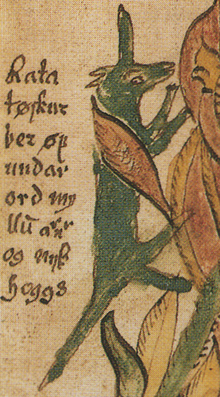Ratatöskr
Ratatöskr , also Ratatosk , Ratatösk or Ratatwisker , is a squirrel in Norse mythology that belongs to the animals of the world tree Yggdrasil . It transmits messages between the eagle in the crown and the serpentine dragon Nidhöggr at the foot of the world tree.
swell
The squirrel is only mentioned in the Song Edda in the song Grímnismál .
Ratatoscr is called ícorni,
he renna scal
at asci Yggdrasils;
arnar orð
hann scal ofan bera
oc segia Níðhǫggvi niðr.
Ratatosk is the name of the squirrel that
leaps around
on the Yggdrasil ash;
it carries
the eagle's words
down from above
and says it below Nidhögg.
- - Grímnismál, verse 32 (translation after Arnulf Krause )
According to this, the squirrel is essentially the messenger of the eagle's messages to the dragon Nidhöggr , who is down at the roots of the world tree. Snorri Sturluson added in his Prose Edda that Ratatöskr also conversely transmits the dragon's messages to the eagle, and that this is how the two fight with each other. For what reason is not mentioned.
Örn an sitr í limum asksins, ok he hann margs vitandi
en í milli augna honum sitr haukr, sá he is called Veðrfölnir.
Íkorni sá, his name is Ratatoskr, renn upp ok niðr eftir askinum
ok berr öfundarorð milli arnarins ok Níðhöggs, [...]
An eagle sits in the branches of the ash, it has a lot of knowledge
and between its eyes sits the hawk named Wedrfölnir.
The squirrel, called Ratatosk, jumps up and down the ash tree.
It exchanges venom between the eagle and Nidhögg.
- - Snorri Sturluson, Prose-Edda: Gylfaginning, Chapter 16 (translation by Arnulf Krause)
research
The squirrel is probably not part of the original basic equipment of the world tree, the roots of which can be traced back to Indo-European times. It is probably a decorative detail from a later period.
The controversial motif between eagle and dragon, on the other hand, could be a motif from the Indo-European era. In Indian mythology, too, the eagle and the snake quarrel. In a fable by the Roman poet Phaedrus , a cat on a tree creates enmity between an eagle in the air and a wild boar by the roots. The quarrel between the eagle and the dragon could symbolize the conflict between the constructive and the destructive forces of the world, the gods and the giants, but this is not necessarily thought to be likely in science.
The name Ratatöskrs, Old Norse Ratatǫskr , is mostly derived from Old Norse rati "drill" and * toskr "tooth (?)", So that the name is translated as "drill tooth, incisor tooth".
Impact history
The German writer Hans Erich Blaich chose Ratatöskr as one of his pseudonyms.
literature
- Rudolf Simek : Lexicon of Germanic Mythology (= Kröner's pocket edition . Volume 368). 3rd, completely revised edition. Kröner, Stuttgart 2006, ISBN 3-520-36803-X .
Individual evidence
- ↑ Lieder-Edda: Grímnismál 32. Text edition based on Titus Project, URL: http://titus.uni-frankfurt.de/texte/etcs/germ/anord/edda/edda.htm , accessed on December 14, 2009.
- ^ Translation after Arnulf Krause: The songs of gods and heroes of the Elder Edda. Philipp Reclam jun. Verlag, Stuttgart 2004, ISBN 978-3-15-050047-7
- ^ Arnulf Krause: The Edda of Snorri Sturluson. Philipp Reclam jun. Verlag, Stuttgart 1997, ISBN 978-3-15-000782-2
- ^ Rudolf Simek: Lexicon of Germanic Mythology (= Kröner's pocket edition. Volume 368). 3rd, completely revised edition. Kröner, Stuttgart 2006, ISBN 3-520-36803-X , p. 343.
- ↑ Jan de Vries: Old Germanic history of religion, Volume 2: Religion of the North Germanic. Verlag Walter de Gruyter & Co., Berlin, Leipzig 1937, § 328 - Rudolf Simek: Lexicon of Germanic mythology (= Kröner's pocket edition. Volume 368). 3rd, completely revised edition. Kröner, Stuttgart 2006, ISBN 3-520-36803-X , p. 343 points out that these parallels do not allow a reliable conclusion about the age of the motive for the dispute.
- ^ Henry Adams Bellows: The Poetic Edda. The Mythological Poems. Courier Dover Publications, Mineola NY 2004, ISBN 978-0-486-43710-1 , p. 97, note 32 online excerpt
- ^ Rudolf Simek: Lexicon of Germanic Mythology (= Kröner's pocket edition. Volume 368). 3rd, completely revised edition. Kröner, Stuttgart 2006, ISBN 3-520-36803-X , p. 343: Bohrerzahn - John Lindow: Handbook of Norse Mythology. ABC-CLIO Ltd, USA 2001, ISBN 978-1-57607-217-2 , p. Xi: Bore-Tooth. - a Tetzner: Germanic legends of the gods (retold according to the sources). Reclam-Verlag, Ditzingen 1992, ISBN 978-3-15-008750-3 , p. 193: Nagezahn
